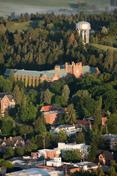Facilities
The University of Idaho Aquaculture Research Institute has research facilities for conducting fish rearing studies both on the Moscow campus and in Hagerman, Idaho. Fish rearing facilities are both indoor and, in Hagerman, outdoor. Indoor facilities are biosecure with environmental controls.
Laboratory managers oversee the fish rearing laboratories at each location and provide the continuity necessary for fish care, feeding and all operations needed for successful research studies by faculty, students and other partners.
The Aquaculture Research Institute (ARI) has research facilities both on the Moscow campus and in Hagerman, Idaho.
On the University of Idaho campus, the ARI operates two wet laboratories that have controlled photoperiods and are supplied with either well or dechlorinated municipal water. A laboratory manager overseas the wet labs and provides the continuity necessary in fish care, feeding and operations for successful studies.
Cold Water Research Laboratory
The Cold Water Wet Laboratory operates as a water-limited recirculating facility. Water comes from three wells located near the facility support the lab’s activities. A backup diesel generator insures the lab’s life-support systems operate in the event of a power outage. There are nine independent recirculating systems that can accommodate a variety of cold water species. In trials conducted at the lab, we have reared multiple salmonid species, sturgeon, and burbot. Each system has independent chilling, biofiltration, and UV treatment. The largest system has four four-meter diameter tanks for rearing of large populations or broodstock. The other systems are comprised of groups of six 680-liter or 1100-liter tanks. Juvenile fish can be housed in either of the recirculating systems use pairs of 350-liter troughs or a system of 48 60-liter tanks. The Cold Water Lab has capabilities to incubate eggs in Heath tray incubators and McDonald jars. Fry can also be held in fiberglass troughs and fed with either single pass or recirculating water. Temperatures in the systems can be maintained between 4 °C and 20 °C.
The Moscow campus wet lab facilities are available to researchers across UI and WSU campuses for a nominal fee.
Burbot Research Facility
The ARI Poultry Hill wet lab (1500 square feet) has been designed to rear non-domesticated cold water fishes and currently holds burbot. The water source for this facility is provided by the campus municipal system. This water is dechlorinated with activated carbon and exposed to UV light. A 1000-gallon solids settling trap and two inline bead filters are used to capture solids before the water is recirculated back to the rearing tanks. There are three six-foot tanks and six five-foot fiberglass circular tanks in the lab that are fed with chilled, recirculating water. Additionally, there are 12 three-foot plastic circular tanks plumbed to receive single pass water or recycled with solids removal capability. Incoming water is carbon filtered and UV sterilized.
The Hagerman Fish Culture Experiment Station is located in south-central Idaho approximately 90 miles southeast of Boise, Idaho, the state capital. The Station is situated on the grounds of the Hagerman National Fish Hatchery, US Fish & Wildlife Service, and was formerly the Tunison Fish Nutrition Laboratory. The University of Idaho leased the facility from the US Fish & Wildlife Service in 1996 and took possession of the 4-acre property in 1998. In 2006, a new 14,000 ft2 building was dedicated, and included housing offices, a classroom and analytical laboratories. A six-bedroom dormitory and additional fish rearing buildings were also constructed, augmenting existing fish rearing facilities and, in the case of the new office/lab building, replacing the original Fish & Wildlife building.
Research is supported by funding from a wide range of sources including competitive grants from agencies, cooperative agreements and collaborative research with partners such as ARS and CRITFC, and with contracts with industry to conduct product testing and evaluation.
The Hagerman Station has both indoor and outdoor fish rearing facilities, all supplied by gravity-fed, constant 15°C spring water. Multiple studies can be conducted at the same time with trout at all stages of life. Ornamental and/or warm-water fish species are raised indoors in recycled water systems.
The Hagerman Station has extensive analytical laboratories used to support research in feeds, molecular biology and population genetics. Teaching is conducted using state-of-the-art video technology linking the Hagerman Station to classrooms on the Moscow campus and elsewhere.
Analytical Genetic Research
The collaborative molecular biology laboratory in Hagerman uses a variety of state-of-the-art equipment and techniques, including next generation sequencing, genomics, metabolomics, parentage analysis and marker-assisted selection, in its basic and applied research activities in fish nutrition, fish physiology, genetics and breeding, molecular ecology and population studies. Researchers in Hagerman address a diversity of research questions ranging from the effects of diet on gut microbiota profiles and global gene expression, to comparing RAD-sequences from warm and cold water adapted rainbow trout, to parentage-based tagging of Columbia Basin Chinook salmon and steelhead. Researchers also collaborate with scientists at other universities and agencies, analyzing samples and sending samples for analysis.
While rainbow trout are the primary species used in research, researchers also undertake studies on white sturgeon, cutthroat trout, zebrafish and tilapia. Visiting students and scholars receive training which enables them to use these innovative techniques in their own studies upon their return.
Fish Nutrition
Fish research studies are the main activity at the Hagerman Fish Culture Experiment Station. Reducing the levels of fishmeal and fish oil in fish feeds is a high priority area of research and involves several approaches. Much effort is made to evaluate alternate protein sources to replace fishmeal. A long-term effort has also been made to develop strains of rainbow trout through selective breeding that exhibit high growth performance when fed all plant-protein feeds. Research to identify essential dietary compounds present in fishmeal and absent in plant proteins that must be supplemented to all plant protein feeds is also part of this research effort. Much of this research is conducted with USDA Agriculture Research Service partners.
Similar efforts are made to lower the use of fish oil in feeds, yet maintain the healthful benefits of long-chain polyunsaturated omega-3 fatty acids in farmed fish products for human consumption. Increasing nutrient retention, meaning the use of nutrients in feeds to support fish growth, is another research thrust that has both economic and environmental benefits. Environmental impacts of fish farming are associated with loss of nutrients, mainly phosphorus, to the environment, so increasing phosphorus retention, for example, reduces the impacts of fish farms on the aquatic environment.
Other Research
Many more topics are addressed in research studies at the Hagerman Station. These include studies associated with improving the survival of hatchery salmon and steelhead trout after release, understanding the basis of tolerance of some strains of fish to high water temperatures or other stressors, and developing novel ways to assess environmental stress in fish using non-lethal methods. CRITFC partners are associated with these efforts as well as with population genetics research on salmon and steelhead throughout the region.
Research involves fish rearing studies but also basic research into how the genome, cells, organs and fish respond to changes in the rearing environment, diet and pathogen challenge. Scientists use molecular techniques as well as proteomics and metabolomics to address these questions.






